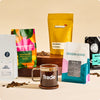The Complete Guide to Coffee Grind Size
Your cheat sheet for every coffee brewing process.
One of our goals at Trade is to empower home brewers to work on your own brewing recipes and have more fun discovering coffee that tastes good to you. Today, we're going over one of the most important and easy-to-adjust brewing method variables: the grind.
To start at square one (or, more aptly, irregularly and inconsistently sized particle one),: grind size refers to how big or small the individual coffee grounds are. Grind size is important because it’s one of the main variables determining how fast your water will dissolve particles that turn your water brown and make coffee taste like coffee. Usually, instead of “big” and “small,” we use the words “coarse” and “fine” to describe the size of grind particles.
Coffee Ground Surface Area
Grind size’s impact has to do with physical processes taking place on a fairly small scale during brewing. When water is trying to get those flavor particles out of an individual coffee ground and into your cup, it can’t just magically teleport to the center of the ground. It has to start from the outside of that coffee particle and wash away those soluble coffee solids first.
So, say you have one coffee particle and you cut it in half. You’re left with the same amount of total coffee, but there’s now a whole lot more surface area from the inside of that particle that the water immediately has access to. The more pieces you divide that coffee particle into, the more surface area will be exposed (while the total mass of coffee stays the same). So in any brew method, finer coffee grounds will extract faster, while coarser coffee grounds extract slower.
Coffee Ground Resistance
In certain brew methods — specifically ones where water flows vertically, down into and through a bed of coffee — grind size has a secondary effect. If you take two batches of coffee and grind one way finer than the other, the way those coffee particles interlock will be different.
An analogy that doesn’t really come from the real world, but seems to make sense to everyone I’ve ever told it to: imagine you’ve filled one tube with rocks and another with sand. If you try to pour water through the rocks, it will go right through, because there will always be big gaps in between the rocks. The grains of sand, however, will have very tiny gaps between them, and it’ll take a lot more time for the water to get through. The same thing is noticeable when you change the grind size in a pour over or, especially, in espresso. If you grind too fine, not only will it provide more extraction, but it will also slow down your flow and increase your total time (which will also increase extraction).
Grinding Coffee at Home
Coffee grinders can be divided into two main camps, blade grinders and burr grinders. Blade grinders work like a food processor or blender, using spinning blades to cut the coffee into smaller and smaller particles. The longer the grinder works, the more coffee particles come into contact with the blades and the smaller they get. Burr grinders are basically two interlocking discs (they can be flat or conical, but for the purposes of this explanation they work pretty similarly) that have sharp teeth on them made from materials like ceramic or stainless steel. While grind size on a blade grinder is determined by time, in a burr grinder, the distance between the burrs determines how big your coffee grounds end up.
Coffee is amorphous — it physically just does not break into even particles. So even in a burr grinder some oddly shaped, bigger particles will slip through the burrs, and some small dust-like particles will be created as well. But most of the coffee you grind will be roughly the same size: the size of that gap between the burrs. In a blade grinder, there are going to be way more different-sized particles in that batch of coffee.
Why is grind size consistency so important? Well, as we try to hammer home fairly often, coffee is a very complex substance that has a lot of different flavor compounds. Compare it to something super simple: table salt. If you add and dissolve salt in a glass of water, that salt is only going to change the flavor of that water in one way: the more salt is dissolved, the saltier that water gets.
Coffee on the other hand, has tastes of sourness, sweetness, and bitterness, not to mention a ton of different aromatic compounds. And those tastes are all extracted from the coffee at different rates (with acidic compounds mostly being easier to extract, and bitter compounds taking a little more effort). So if you have inconsistent coffee grounds, you’ll extract too much bitterness from some of those fine particles and just acidity from some of the coarse ones, making it hard to get a consistent, delicious cup of coffee.
While we heartily recommend burr grinders, that doesn’t mean you can’t take steps to make your blade grinder work for you. Remembering how big the grind size looks is obviously necessary, but note down how long you’re grinding for and the amount of coffee you’re using. Aim for as consistent as possible.
The Grind Size for Every Coffee Brewing Process
Adjusting grind size for specific recipes is part of the fun of brewing at home, but general grind size recommendations do exist — and for good reason. Some grinders have labels on them denoting different brew methods, but if yours doesn’t, here’s a quick guide:
- Turkish coffee gets ground as fine as possible, because those super-fine particles help with the desired body of the coffee, but also because the coffee grounds are only in contact with really hot water for a short part of the brewing time. Those tiny particles are necessary for extraction speed.
- Espresso is ground slightly coarser, but still very finely. Again, we need those fine particles because of the super-short brew time. They’re also very important for providing resistance to the water. Espresso is brewed under high pressure, which increases extraction speed, but without that fine grind enabling us to push those grinds super-close together, the pressurized water would just shoot through coffee bed too quickly for an even espresso.
- For pour over and automatic drip brewers, we tend to grind somewhere in the medium range. Generally, for smaller, single-serve pour overs, we’ll go a little finer. Since we’re using less water, it’s going to be harder to extend the brew time, so the finer grind will help extract quickly. Also, the resistance from the finer coffee grounds will help the water drip more slowly. If you're brewing a gallon and a half of coffee at once (say in a coffee shop), grind closer to medium-coarse, so as not to extract too much or make it too hard for that water to go through.
- For a French press, grind pretty coarsely. While this helps with extraction (resistance isn’t really a concern, because the water’s just sitting there), it’s also largely because the filter of the French press would let too many small particles through if ground finer.
- Cold brew coffee beans are also ground pretty coarsely, both because of its extended brew time and its filtration, which usually isn’t quite as fine as the paper filter in a drip machine.
Adjusting Coffee Grind Size
While you’ll want to stay within these general neighborhoods for grind size, most grinders have plenty of wiggle room to make smaller adjustments. Use those adjustments to help brew coffee that’s not just delicious, but exactly to your taste.
The lower a percentage of the brown stuff in your coffee grounds extracted into your cup, the more acidic your coffee will be. The higher a percentage, the more bitter. So if your pour over tastes too bitter, go a little coarser, repeat all the other steps and it should help. If your French press tastes too sour and is missing a bunch of sweetness, grind a smidge finer and it should taste more balanced.
Every coffee is different, so you’re not going to get a dark-roasted Brazil to taste super-bright just by grinding coarse, and you’re not going to get a flowery- washed Ethiopia to taste like a dark chocolate bar by grinding fine. But in highlighting rich, chocolaty Brazilian notes and that Ethiopian's floral flavor, it’s a vital adjustment to understand.

What grind size is best for French press coffee?
- For French press coffee, a coarse grind is recommended to prevent grounds from seeping through the mesh filter and to achieve a full-bodied brew.
What grind size should I use for drip coffee makers?
- Drip coffee makers work best with a medium grind, allowing optimal extraction and balanced flavor.
Is there a specific grind size for espresso?
- Yes, espresso requires a fine grind to ensure proper extraction and the characteristic strong flavor and crema.
Can I use the same grind size for all brewing methods?
- While some grind sizes overlap between brewing methods, it's generally best to adjust the grind size based on the specific requirements of each technique for the best results.
How does grind size affect the taste of coffee?
- Grind size is crucial in determining coffee's extraction rate and flavor profile. Finer grinds typically produce more robust, intense flavors, while coarser grinds produce a milder taste. Adjusting the grind size allows for fine-tuning the taste of your coffee to your preferences.
Elevate Your Home Coffee Brewing with Trade
Are you looking to take your home coffee brewing to the next level? Look no further than Trade. Our mission is simple: to connect coffee lovers with the finest beans from the best roasters across the country. With our coffee subscription service, you'll receive freshly roasted beans tailored to your taste preferences and delivered right to your doorstep.
How It Works:
- Customized Selection: Take our quiz to discover your coffee preferences, and we'll curate a selection of beans just for you.
- Freshness Guarantee: Enjoy freshly roasted beans every time, ensuring every cup's highest quality and flavor.
- Convenient Delivery: Say goodbye to running out of coffee. With our subscription, you'll never have to worry about running low on your favorite brew.
- Flexible Plans: Choose from weekly, bi-weekly, or monthly deliveries, and easily adjust or pause your subscription anytime.
- Expert Curation: Our team of coffee experts hand-selects each coffee to ensure a diverse and exciting lineup of beans for you to explore.
At Trade, we're passionate about connecting coffee drinkers with the best coffee experiences possible. With a focus on quality, sustainability, and community, we strive to elevate every aspect of the coffee journey.
Subscribe Today
Ready to elevate your at-home coffee game? Join thousands of coffee lovers who trust Trade to deliver exceptional beans straight to their door. Subscribe now and experience the difference for yourself.






